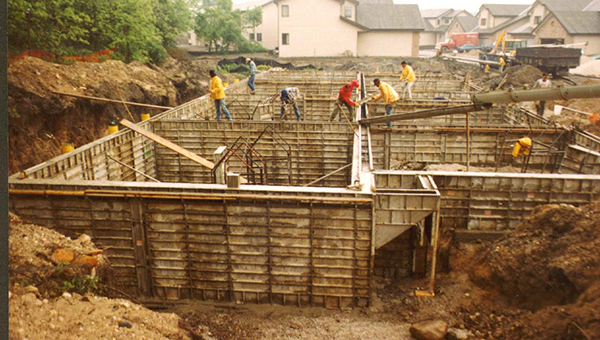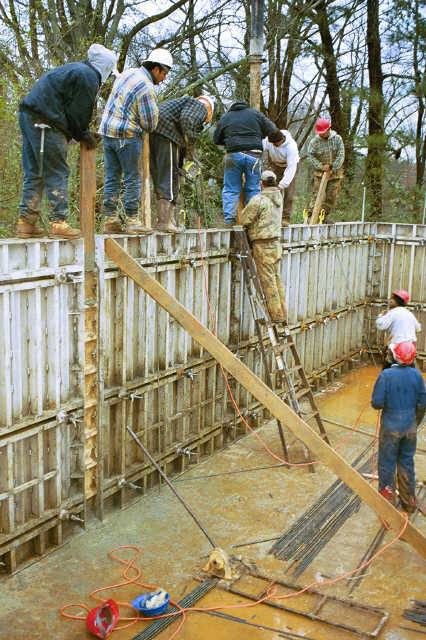Maintaining “Alternative Fall Protection Plans” Under OSHA Regulations
Adequate Fall Protection in Residential Concrete Foundation Pouring:
Maintaining “Alternative Fall Protection Plans” Under OSHA Regulations
By Michael G. Latiff and Mark W. Steiner
On May 1, 2017, the secretary of labor for the Northeast District of Ohio issued what can be fairly characterized as an unprecedented serious citation to a residential concrete foundation contractor, following a routine inspection of a residential construction site. In short, the contractor was performing his work the way he always had: After setting the forms, he had an employee walk along the top of the formwork to guide and pour the concrete for the home’s foundation. The citation alleged that the contractor had failed to maintain adequate fall protection for his employees. A vigorous defense was mounted, and ultimately OSHA withdrew the improper citation. The purpose of this article is to make industry members aware of the issues and regulations highlighted in cases like this, so that they can maintain a proper level of safety in the services they provide.
In this particular instance, the improper citation was issued under the regulatory provision 29 C.F.R. § 1926.501(b)(5) (from here referred to as “[b][5]”), which governs fall protection for those who work on the “face of formwork or reinforcing steel.” This citation was in lieu of the more common provision for such matters, 29 C.F.R. § 1926.501(b)(13) (from here referred to as “[b][13]”), which governs fall protection for residential construction. On the face of it there does not seem to be much difference between the two provisions. The difference is, however, significant in that the only fall protection standards permitted by (b)(5) are “personal fall arrest systems, safety net systems, or positioning device systems.”[1] Any other form of fall protection not referenced in (b)(5) ,including those generally accepted and used in residential construction, would be noncompliant and could result in a citation. In essence, the OSHA citation issued had the potential to change the way the contractor, and every other concrete foundation contractor, has performed his work over the past 40-plus years. If the citation had been maintained and upheld, the consequences would have been severe to the industry. Fortunately, it was not.
Importantly, (b)(13) contains a key limitation that permits contractors who engage in residential construction to “demonstrate that it is infeasible or creates a greater hazard to use . . . guardrail systems, safety net systems, or personal fall arrest systems.” Indeed, in such situations, the employers may implement their own compliant alternative fall protection plan under 29 C.F.R. § 1926.502(k), providing for much greater flexibility in implementing a safe and compliant plan.[2] While the difference between (b)(5) and (b)(13) initially may seem minor, the secretary’s (b)(5) citation to the contractor put at risk the industry’s ability to develop alternative fall protection plans for residential concrete foundation pouring to better suit the needs of a particular site and the employer’s employees. In residential construction cases, it may not be possible to implement the specific fall protection methods provided in (b)(5). While the contractor had an alternative fall protection plan, it could not be used as a defense to the citation due to the Northeast District of Ohio’s position that (b)(5) applied.
The issue was important to the contractor’s business and important to the entire residential construction industry. So, along with the support of the CFA, the contractor mounted a defense to the citation. In his defense, the contractor made several arguments to show that (b)(5) was an improper citation. He argued that the history of (b)(13) made clear that it, and not (b)(5), was the controlling regulation; that OSHA’s guidance documents demonstrated that (b)(13) was the governing standard; that foundation pouring does not occur on the “face” of formwork (which is where [b][5] would apply); and OSHA’s application of this regulation was inconsistent with other cases. In the end, and after significant input from the National Director of OSHA, the contractor resolved the citation favorably, with OSHA ultimately withdrawing the initial citation and allowing the contractor to continue using an alternative fall protection plan – a significant concession for the entire industry.
 The History of 29 C.F.R. § 1926.501(b)(13) in Residential Construction
The History of 29 C.F.R. § 1926.501(b)(13) in Residential Construction
The standards involving fall prevention in residential construction were not always as stringent as they are today. In fact, on Dec. 8, 1995, OSHA published an interim fall protection compliance policy related to fall protection for residential activities. That standard identified certain tasks that could be performed without the use of any conventional fall protection, as long as the employer followed certain specified guidelines. Indeed, the 1995 standard relieved the residential homebuilder from any obligation to show “infeasibility or greater hazard” when electing to use alternative fall protection plans in lieu of conventional fall protection and accordingly, this standard provided employers with the most flexibility in determining their own fall protection policies.
On June 18, 1999, however, the standard was revised, implementing a form of (b)(13). The standard stated that employers involved in certain residential construction activities, including those “working on concrete and block foundation walls and related formwork” specifically, had a number of available alternative procedures with which they may choose to comply with to fulfill fall protection requirements. The standard further stated that “[n]o other provision may be cited for a fall hazard addressed by (b)(13).”
The residential fall protection standard was yet again revised, to be effective on June 16, 2011. This revision eliminated the specific categories of residential construction activities (eliminating the specific reference to “concrete and block foundation walls and related formwork”), instead requiring employers in residential construction to demonstrate “the infeasibility of required fall protection systems, or that such systems create a greater hazard, prior to implementing alternative measures under [(b)(13)] and 1926.502(k).” The standard, however, admitted that residential construction was different than commercial or industrial construction, stating:
OSHA acknowledges that there may be isolated situations in which it is infeasible or creates a greater hazard to use conventional fall protection in residential construction, but the Agency believes that 29 CFR 1926.501(13) [sic] provides sufficient flexibility to accommodate employers in those situations. Any employer doing residential construction that can demonstrate that the use of conventional fall protection is infeasible or creates a greater hazard may use a fall protection plan and alternative fall protection measures in accord with 29 CFR 1926.502(k).[3]
Given the history of (b)(13) and its prior references specifically to foundation and formwork, it has always been applied in cases of pouring concrete foundations in residential construction cases.
In fact, OSHA issued an “OSHA Guidance Document” evaluating “Fall Protection in Residential Construction.” The document specified that OSHA designed it to assist employers after the standard from June 2011 (the most recent standard) was issued. The document discusses the use of various fall protection methods related to foundation walls and formwork. Even after OSHA issued the June 2011 standard, it appeared that OSHA contemplated applying (b)(13) in the foundation-pouring context.
 The Text of 29 C.F.R. § 1926.501(b)(5) Does Not Support Application in Certain Residential Foundation Cases
The Text of 29 C.F.R. § 1926.501(b)(5) Does Not Support Application in Certain Residential Foundation Cases
In many cases of residential concrete foundation pouring, employees stand on the top of formwork to pour the foundation. The text of (b)(5) says: “[e]mployees working on the face of formwork or reinforcing steel at a height above 6-ft shall be protected by means of guardrails, safety nets or lanyards.” The key term in the provision is that an employee must work “on the face of formwork” for the cited standard to apply. There is no precise definition of “face of formwork” in any of the OSHA regulations or documents. However, pursuant to industry standards, construction guides and common sense, the “face of formwork” would not include “working on the top of concrete formwork.” Pursuant to documents published by the American Concrete Institute, the industry definition of the term indicates that the “face of formwork” is the vertical surface that imparts shape and texture to the concrete without the means of a concrete finisher.[4] By industry standards, then, OSHA’s effort to issue a citation under (b)(5) when employees were working on the top of formwork was misplaced and needed to be challenged.
Other Cases Support 29 C.F.R. § 1926.501(b)(13)
Several other residential formwork contractors throughout the country, many of whom are members of CFA, have been cited under (b)(13) rather than (b)(5). Indeed, in April, 2017, a Delaware contractor was cited under (b)(13) for permitting employees to pour cement while standing on top of the forms, without complying with the fall protection standards under (b)(13). While the citation in that matter did not mention a specific “Alternative Fall Protection Plan,” OSHA did appropriately recognize the applicability of (b)(13). This is true for other recent citations around the country with similar situations regarding residential formwork.
Conclusion
Ultimately, OSHA relented and withdrew the improper citation, recognizing the use of alternative fall protection plans in residential construction formwork. This is an important victory for the industry, as it allows employers that work in residential foundation construction to implement their own alternative fall protection plans. Awareness of this issue is important, as it prepares employers to challenge citations that put residential foundation construction under a particular standard that does not allow for alternative fall protection plans. While it appears to be OSHA’s policy at the national level to allow alternative fall protection plans in residential foundation pouring, some regions and districts may not be aware of the national position. Or, in some cases, a region may simply choose initially to attempt to implement harsher standards, like the Northeast District of Ohio did in this particular instance. Safe work sites remain the ultimate goal of all employers but knowing your rights and the current regulation interpretations that affect your industry is essential to a safe operation.
This article is designed to provide current information regarding important legal developments. The foregoing discussion is general information rather than specific legal advice. Because it is necessary to apply legal principles to specific facts, always consult your legal advisor before using this discussion as a basis for a specific action. This article does not create an attorney-client relationship.
Michael G. Latiff is a Member of McDonald Hopkins, a business advisory and advocacy law firm located at 39533 Woodward Avenue, Suite 318, Bloomfield Hills, Mich. 48304. Telephone: 248-220-1351. Email: mlatiff@mcdonaldhopkins.com. Corporate website: www.mcdonaldhopkins.com. Michael will be a featured speaker at Concrete Founations Convention 2019 | Denver, Colo. – July 25-27, 2019 on the subject of “What To Do When OSHA Shows Up.”
©2018 McDonald Hopkins LLC All Rights Reserved
[1] 29 C.F.R. § 1926.501(b)(5)
[2] 29 C.F.R. § 1926.502(k) contains several requirements for drafting and maintaining a compliant alternative fall protection plan, including (but not exclusively) that it must be drafted by a qualified person, developed for the specific site, performed and maintained, and supervised properly. Any changes of the plan must be approved by a qualified person, and a copy of the plan must be maintained at the site. The plan must document the reasons a conventional method of fall protection is infeasible or hazardous. There must be a written discussion to reduce or eliminate the fall hazard. The plan must identify each location where the fall protection methods cannot be used, and the employer must maintain a safety monitoring system. The plan must identify each employee who is designated to work in controlled access zones, and in the event of the fall, the employer must investigate the circumstances to determine whether a change in the plan is necessary.
[3] STD 03-11-002.VIII.D.
[4] ACI 347.3R-13. “Guide to Formed Concrete Surfaces.” 4.1, 4.4.1, 4.4.2, Table 3.1C.







